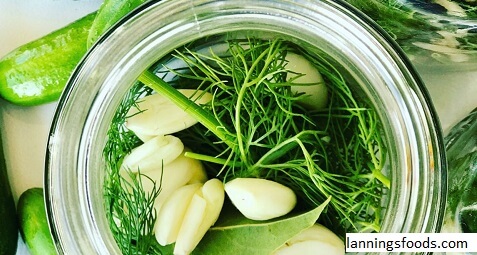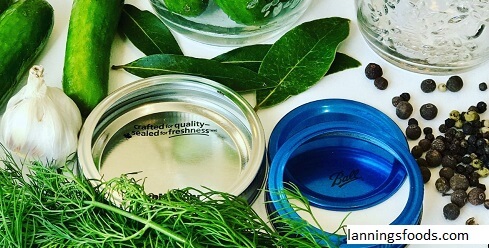Fanny Farmer Dill Pickles: Classic Recipe for Homemade Perfection
Recipe:
Dill pickles are among the favorite pickles of people, adored not only by their crunchy texture and sour taste but have been for a long time the apple in the eye of so many. Among the various downpour recipes passed on from generation to generation, Fanny Farmer Dill Pickles stands as the quintessential definition of that fateful classic recipe.

Fanny Farmer, the American icon of cookbooks, has inspired generations of home cooks with meticulous style and approachability. Let’s get into her recipe for dill pickles, guide you on how to make your own, dive into the history of pickling, the ingredients that you’ll need, and some frequently asked questions.
The History of Pickling:
Recipe:
Pickling is one of the oldest food preservation methods known and can trace its roots back thousands of years. Different cultures have managed to come up with their own techniques for pickling through the use of different types of ingredients and spices. Normally, it involves the submersion of food within a solution composed of vinegar, salt, and sometimes other spices, all designed to inhibit bacterial growth.
In America, pickles were very fashionable during the 19th century, when many German immigrants brought their pickling traditions to this land. Fanny Farmer’s contributions to American cooking were made at a time when home cooking was finally becoming an enjoyable activity. Indeed, recipes seem to be created simple and rich with traditional techniques.
Ingredients for Fanny Farmer Dill Pickles:
Recipe:
To make Fanny Farmer’s delicious dill pickles, you will need the following:
For the Pickles:
- Fresh cucumbers: 4 to 5 lbs, preferably pickling varieties
- Fresh dill: 1 bunch or 1 tablespoon of dill seeds
- Garlic: 4-6 cloves, peeled and crushed
- Mustard seeds: 1 tablespoon
- Black peppercorns: 1 tablespoon
- White vinegar: 3 cups
- Water: 2 cups
- Pickling salt: ½ cup
- Sugar: 1 tablespoon, optional for a little sweetness
Equipment:
- Canning jars – any size from pint to quart
- Lids and bands for canning
- Large pot for water bath
- Jar lifter and funnel (optional but great fun.)
- Clean towels
Step-by-Step Instructions:
Recipe:

Step 1: Prepare the Cucumbers
Recipe:
- Choose Fresh Cucumbers: Pickling cucumbers need to be firm and small to medium in size. Avoid using overly ripe, soft, or mushy cucumbers.
- Wash: Wash cucumbers under cold running water to wash off any dirt or debris.
- Cut: If desired, use whole cucumber; cut into spears, coins, or leave intact.
Step 2: Prepare the Pickling Brine
Instructions:
- Mix Ingredients: Combine white vinegar, water, pickling salt, and sugar in a large pot.
- Heat: Bring mixture to a boil over medium heat. Stir constantly until salt and sugar are dissolved. Remove from heat and let cool slightly.
Step 3: Pack the Jars
- Sterilize Jars: Sterilize the canning jars before filling, washing them in boiling water for 10 minutes. Let them cool.
- Add Spices: Place a few fresh dill sprigs, 1-2 cloves of garlic, mustard seeds, and black peppercorns in each jar.
- Fill with Cucumbers: Put the cucumbers into each jar, leaving no more than ½ inch headspace at the top of the jar.
Step 4: Add the Brine
Recipe:
- Pour the Brine: Pour the hot brine over the cucumbers in each jar, making sure that they are covered. To make a mess, use a funnel.
- Seal the Jars: Apply a clean towel to wipe the rims clean of any residue left; apply the lids and screw bands onto them until they’re only fingertip tight.
Step 5: Process the Jars
- Water Bath Canning: Place the jars into the water bath for 10-15 minutes. This is the processing part, where the pickles are sealed correctly so the pickles can be safely stored.
- Cool: Remove the jars from the water bath and set them to cool on a clean towel or rack. You should hear the lids “pop” as they seal.
Step 6: Store the Pickles
- Check the seals on the jars after cooling. If the lid is indented in the center, then the jar has sealed well. These should be kept in a cool, dark place for at least 4 to 6 weeks before eating for full flavor.
Tips for Producing Great Dill Pickles:
Recipe:
- Use Good Stuff: The quality of your cucumbers and spices will greatly determine how your pickles will eventually taste.
- Feel free to play with flavors: Sprinkle red pepper flakes if you like it a little spicier or even add more thyme and oregano for an extra herbiness.
- Fresh Dill: If you happen to use fresh dill, this flavor will be way stronger; so cut back if you use dried.
- Variations: Balance the vinegar to ratio taste if you want it more sharper or mellow.
- Keep an Eye on Seals: If a jar doesn’t seal right, place it in the refrigerator and use the pickles within a few weeks.
Frequently Asked Questions About Fanny Farmer Dill Pickles:
Recipe:
1. How long will the homemade dill pickles last?
Homemade dill pickles keep for up to a year if kept cool and dark. Once opened, they will need to be stored in the refrigerator and used within a few weeks
2. Can I use different kinds of cucumbers?
While the recipe calls for pickling cucumbers, which are perfect because they are firm and small, you can use any variety. It all depends on what’s in your locality, and how you like them-texturally, that is.
3. Do I need to use pickling salt?
You should use pickling salt because that’s pure salt without additives that might cloud the brine. If you don’t have pickling salt, you could substitute it with kosher salt, but never table salt.
4. Can I water bathe these pickles?
Recipe:
Although the following process is safe, the water bath canning method is the best to ensure the jar seals properly and all bacteria are killed. If this is not done properly, there is a good chance spoilage will occur.
5. How do I know my pickles are firm enough?
Soft pickles are produced if the cucumbers are overripe or have an incorrect brine concentration. Always ensure you use fresh cucumbers and the right concentration of brine.
Conclusion:
Recipe:

Making Fanny Farmer’s dill pickles is one exciting way to maintain the essence of summer and have a fresh thirst quencher throughout the year. This recipe will let you enjoy the flavors of fresh cucumbers grown in your garden, besides incorporating the joy of traditional canning into your kitchen. On this adventure of pickling go out, and make it your style! Whether you like them as a crunchy snack, a flavor addition to sandwiches, or even on a relish tray, homemade dill pickles will be dearly loved additions to your culinary repertoire. Happy pickling!